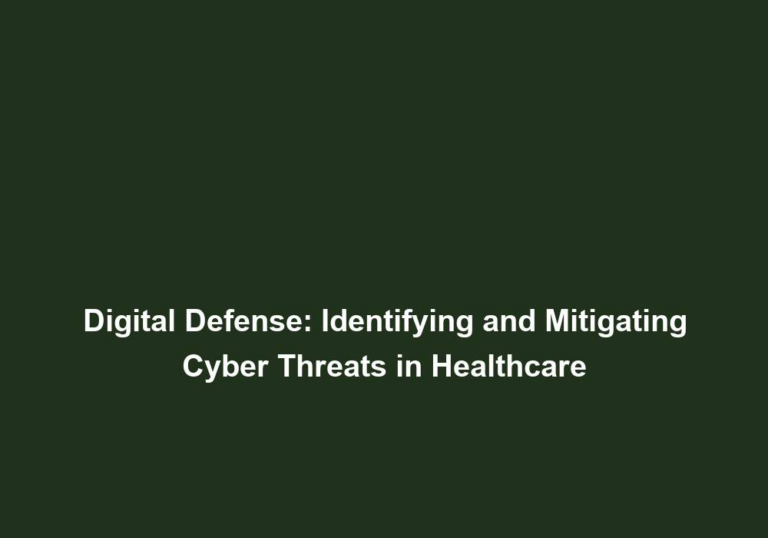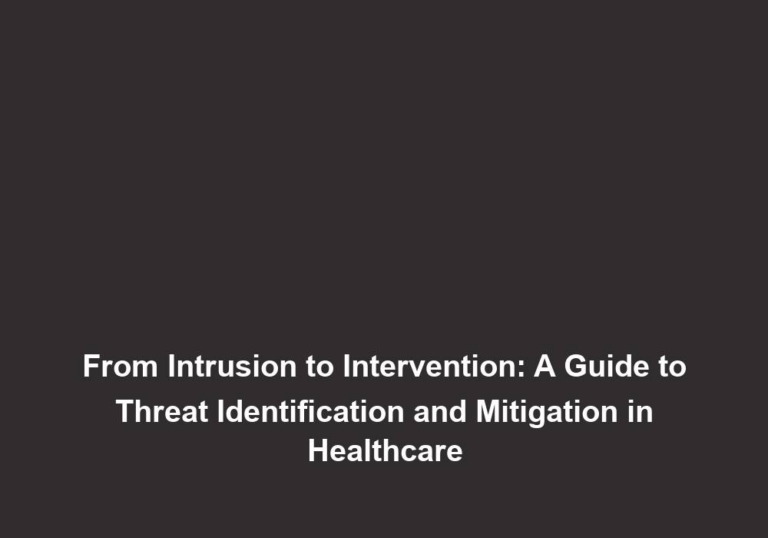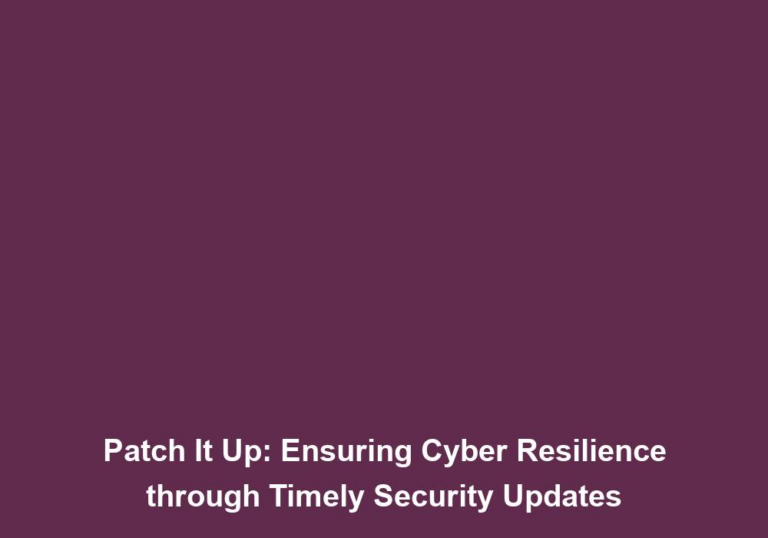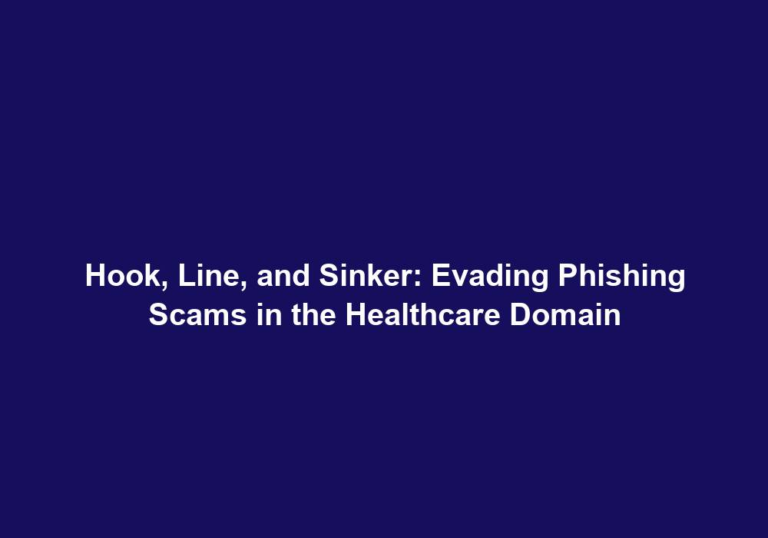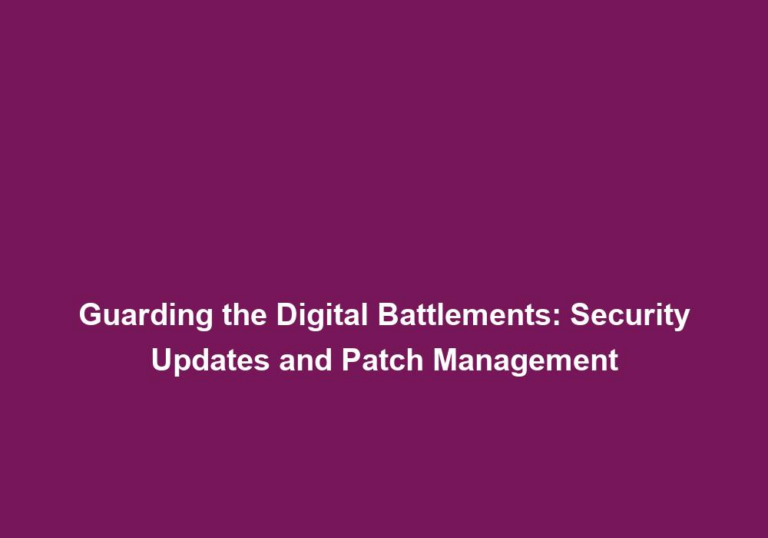Bait and Switch: Decoding Phishing and Scams in Healthcare
In today’s digital age, healthcare organizations are becoming increasingly vulnerable to cyber threats such as phishing and scams. These malicious activities aim to deceive individuals and gain unauthorized access to sensitive information, posing a significant risk to both patients and healthcare providers. It is crucial for healthcare professionals and individuals to understand these threats and take proactive measures to protect themselves and their organizations. In this article, we will delve into the world of phishing and scams in healthcare, decoding their intricacies and offering practical tips for prevention.
Understanding Phishing Attacks
Phishing attacks involve the use of deceptive techniques to trick individuals into disclosing confidential information, such as usernames, passwords, or financial details. These attacks often take the form of emails, text messages, or phone calls that appear to be from trusted sources. In the healthcare industry, phishing attacks can target patients, healthcare providers, or even the organizations themselves.
Common Tactics Used in Phishing Attacks
Phishers employ various tactics to carry out their attacks effectively. By familiarizing ourselves with these tactics, we can better recognize and protect against phishing attempts. Some common tactics used in phishing attacks include:
- Spoofing: Phishers often mimic legitimate email addresses or websites to create a false sense of trust. They may use similar domain names or logos to make their fraudulent communications appear genuine. This technique can deceive individuals into sharing sensitive information.
- Urgency and Fear: Phishing emails may create a sense of urgency or fear to manipulate recipients into taking immediate action. For example, an email claiming that a patient’s medical records have been compromised and they need to provide personal information to resolve the issue. By exploiting emotions, phishers increase the chances of successful phishing attempts.
- Hyperlinks and Attachments: Phishing emails may contain malicious links or attachments that, when clicked, can install malware or direct users to a fake website designed to steal sensitive information. These links and attachments often appear harmless, enticing individuals to click on them unknowingly.
- Social Engineering: Phishers often leverage psychological manipulation techniques to exploit human vulnerabilities. They may personalize emails or use social engineering tactics to make their requests seem legitimate. By creating a sense of trust and familiarity, phishers increase the likelihood of individuals falling for their scams.
Impact of Phishing Attacks in Healthcare
Phishing attacks in healthcare can have severe consequences, affecting both individuals and organizations. Some of the potential impacts of phishing attacks include:
- Patient Data Breaches: If successful, phishers can gain access to patients’ personal and medical information, which can be sold on the dark web or used for identity theft. This can lead to financial losses and significant harm to individuals whose sensitive information is compromised.
- Financial Losses: Phishing attacks can lead to financial losses for healthcare organizations, as fraudsters may gain unauthorized access to banking or payment systems. This can result in monetary damages and disrupt the financial stability of healthcare providers.
- Reputation Damage: Falling victim to phishing attacks can damage the reputation and trustworthiness of healthcare organizations, leading to a loss of patients or clients. The negative publicity associated with data breaches can have long-lasting effects on an organization’s credibility.
- Legal and Regulatory Consequences: Healthcare organizations may face legal and regulatory consequences if they fail to protect patient data adequately. Non-compliance with data protection regulations can result in hefty fines and damage the organization’s standing within the healthcare industry.
Recognizing and Preventing Phishing Attacks
Preventing phishing attacks requires a combination of user awareness and organizational security measures. By implementing best practices, individuals and organizations can significantly reduce the risk of falling victim to phishing attempts. Here are some effective strategies for recognizing and preventing phishing attacks:
User Awareness:
- Education and Training: Regularly train employees and individuals on recognizing and reporting phishing attacks. Teach them to scrutinize emails for suspicious grammar, spelling errors, or unexpected requests for sensitive information. By educating individuals about the warning signs of phishing, they can become more vigilant and better equipped to identify potential threats.
- Verification: Encourage individuals to independently verify the authenticity of any requests before sharing personal or sensitive information. They should directly contact the organization using trusted contact information to confirm the legitimacy of the request. Verifying the legitimacy of requests can help individuals avoid falling prey to phishing scams.
- Two-Factor Authentication: Enable two-factor authentication for email accounts and other sensitive systems. This adds an extra layer of security by requiring a second form of verification, such as a unique code sent to a mobile device. Two-factor authentication can significantly reduce the risk of unauthorized access, even if phishing attempts are successful.
- Reporting: Establish a clear reporting mechanism for suspected phishing attempts. Prompt reporting allows organizations to take immediate action and mitigate the risks. Encourage individuals to report any suspicious emails, messages, or phone calls to the appropriate authorities within the organization. Reporting incidents can help prevent further damage and aid in the identification of phishing patterns.
Organizational Security Measures:
- Email Filtering: Implement robust email filtering systems to identify and quarantine phishing emails before they reach user inboxes. By detecting and blocking suspicious emails automatically, organizations can prevent individuals from being exposed to potential phishing threats.
- Multi-Layered Defense: Deploy multiple layers of security controls, including firewalls, intrusion detection systems, and antivirus software, to prevent and detect phishing attacks. By combining various security measures, organizations create a robust defense against phishing attempts, making it more challenging for cybercriminals to succeed.
- Regular Updates and Patches: Ensure that all software and systems are up to date with the latest security patches to address any vulnerabilities that phishers may exploit. Regular updates help organizations stay ahead of emerging threats and protect against known vulnerabilities.
- Employee Access Control: Restrict user privileges to only necessary systems and data. Implement strong password policies and regularly change passwords to minimize the risk of unauthorized access. By limiting access to sensitive information, organizations reduce the potential impact of successful phishing attacks.
Recognizing Healthcare Scams
Apart from phishing attacks, the healthcare industry is also susceptible to various scams that target patients, providers, and organizations. These scams can take different forms, such as fraudulent billing schemes, fake insurance plans, or counterfeit medications. It is crucial to be aware of these scams and take preventive measures to safeguard against them.
Examples of Healthcare Scams
- Medical Identity Theft: Scammers may use stolen personal information to fraudulently obtain medical services or prescriptions, resulting in financial losses and potential harm to patients. By assuming someone else’s identity, scammers can exploit healthcare resources and put patients at risk.
- Bogus Health Products: Scammers may promote fake health products or miracle cures, preying on vulnerable individuals seeking quick fixes for their health issues. These products often lack scientific evidence and can have adverse effects on individuals’ health.
- Phony Billing: Fraudulent billing schemes involve submitting false claims to insurance companies or patients for services that were never provided. This can result in financial losses for individuals and insurance providers. It is essential to review medical bills carefully and report any suspicious charges promptly.
Preventive Measures against Healthcare Scams
To protect oneself from healthcare scams, individuals can take the following preventive measures:
- Verification: Always verify the credibility and legitimacy of healthcare providers, insurance plans, or products before making any financial commitments or sharing personal information. Research the reputation of providers and read reviews from reliable sources to ensure their authenticity.
- Secure Online Transactions: Ensure that you are using secure connections and trusted websites when dealing with online healthcare services or purchasing medications. Look for secure website indicators such as “https” in the URL and a lock icon in the address bar.
- Review Medical Bills: Regularly review medical bills and insurance statements for any discrepancies or unfamiliar charges. Report any suspicious activity to your insurance provider or healthcare organization. By carefully examining bills, individuals can identify potential fraudulent activities and take appropriate action.
- Stay Informed: Keep yourself updated about the latest scams and fraud schemes prevalent in the healthcare industry. Government agencies and consumer protection organizations often provide information and resources to help individuals stay vigilant. By staying informed, individuals can recognize emerging scams and protect themselves from falling victim to fraudulent schemes.
Conclusion
As the healthcare industry becomes more reliant on digital technologies, the risks associated with phishing attacks and scams continue to grow. By understanding the tactics used by cybercriminals and implementing preventive measures at both the individual and organizational levels, we can mitigate the risks and ensure the security of sensitive healthcare information. Remember, staying informed, educating staff and patients, and maintaining strong security practices are crucial in combating these threats and protecting the integrity of the healthcare system.


